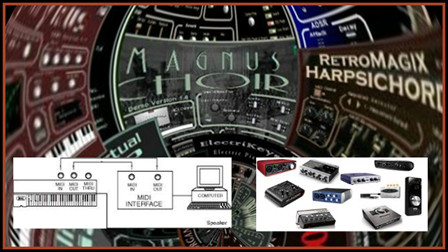
Making Music with
MIDI

About MIDI -
Making Music with MIDI
- MIDI Controllers -
MIDI Products -
MIDI Glossary
-
MIDI Polyphonic
Expression (MPE)
Play,
Create, Learn... it's all MIDI
Unlike MP3 files
and CDs, MIDI files contain individual instructions for
playing each individual note of each individual instrument. So
with MIDI it is actually possible to change just one note in a
song, or to re-orchestrate an entire song with entirely
different instruments. And since each instrument in a MIDI
performance is separate from the rest, its easy to isolate
individual instruments and study them for educational
purposes, or to mute individual instruments in a song so that
you can play that part yourself.
Here are just
some of the tangible advantages of using MIDI for active
music-making.
Play with "a band"
Learning to play
a musical instrument is one of the most rewarding things
people can do. But why play by yourself when you can play
along with a band? Standard MIDI Files are available
for many popular songs, and when used with a personal computer
or digital piano make it possible to have an entire backing
band play along with you at whatever speed (tempo) and in any
pitch (key) you desire. MIDI files are perfect for practicing
with, as well as for performing when additional musicians are
not available.
Correct Your Performance
A MIDI sequencer
or a ‘Digital Audio Workstation' can record your performances
for listening at a later time, and even save your performance
in Standard MIDI File format for playback on other MIDI
systems. This is a great way to evaluate your own progress, or
even to study how someone else plays.
Better yet,
because all MIDI data is editable, you can edit out any
imperfections! If you play a wrong note, you can just change
it using the Sequencer's editing tools. And if you find you
just can't play fast enough to keep up with the tempo, you can
slow it down for recording and speed it back up for playback
-- without the "Mickey Mouse" effect that normally comes from
speeding up a song.
Play Any Instrument
When you use MIDI
to make music, you aren't limited to playing just one
instrument. No matter what sort of MIDI Controller (keyboard,
guitar, wind, drums, etc.) you actually use, you can make it
sound like just about any instrument you can imagine (and some
that are only in your imagination). Most digital pianos and
other MIDI instruments come with hundreds of different sounds
(pianos, trumpets, violins, guitars, basses and more) which
you can play yourself or play via a MIDI sequencer to create
fully orchestrated music.
Arrange and Orchestrate
Many people enjoy
arranging and orchestrating music as much as performing it.
There are MIDI files available for songs from every style of
music -- as well as software programs that generate the basic
rhythm and chord patterns that define specific styles -- that
you can use to create your own arrangements and
orchestrations. Just change the instrumentation, add a verse
or chorus here or there, even put in your own original phrase
or section -- all of this is easy to do with MIDI. You can
also share your arrangements with other people, who can then
rearrange them to fit their own needs -- many people download
MIDI files from the Internet and rearrange them to fit their
own needs.
Print Sheet Music
When you are done
creating your own performance or arrangement, if you have a
personal computer, you can convert MIDI information into
musical notation and print out actual sheet music. Even if you
can't play a note, MIDI Notation programs often make it
possible to place notes on a musical staff using your mouse or
computer keyboard. There are Notation programs available for
every level and pocket book -- from professional engraving to
casual use.
Compose Music
If you've ever
had an original song idea in your head and wished you could
have it performed, MIDI is the way to do it. All you need is a
MIDI Sequencer , plus a MIDI instrument to enter
notes with. (You can also use MIDI Notation software to place
notes on a musical staff without playing them at all.) You can
start with just a melody and then add backing chords, bass,
and rhythm later, or add instruments in any order you like. If
you make mistake, you can change it without having to play the
part all over again. You can also make entire sections repeat
without playing them again. And you can rearrange and
re-orchestrate your song as many times as you like.


MIDI is a
trademark of MIDI Manufacturers Association Incorporated.
About MIDI -
Making Music with MIDI
- MIDI Controllers -
MIDI Products -
MIDI Glossary
-
MIDI Polyphonic
Expression (MPE)

